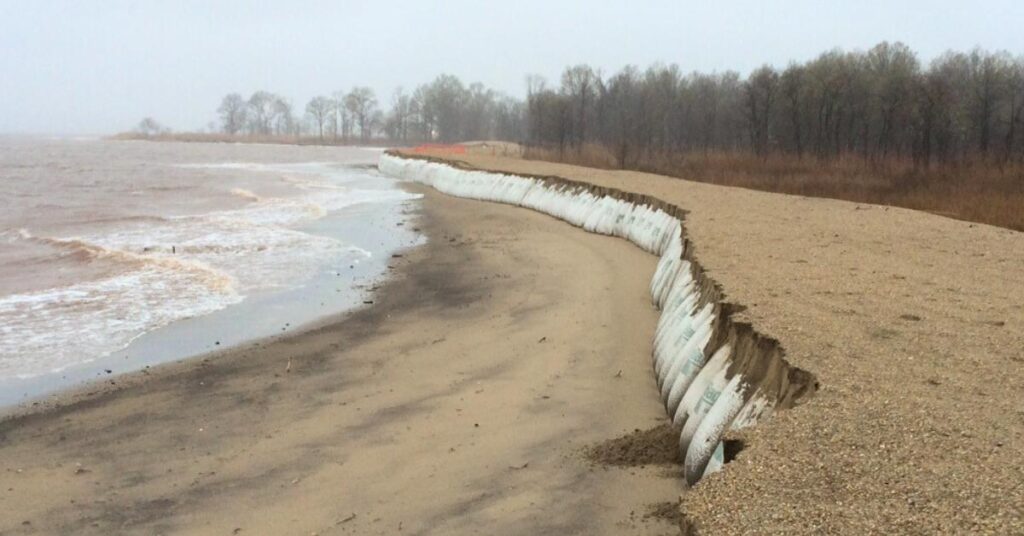Erosion and Flood Protection in France
TrapBags can be used for effective erosion prevention and flood protection along the rivers and coastlines of France.

The rich geological diversity and extensive coastlines of France make it a beautiful place to live, but it also makes the country a prime candidate for a range of different flooding scenarios. Unfortunately, climate change is also expected to increase the rate of major flooding events throughout Europe.
That’s why it’s vital for communities to have effective erosion and flood control barriers that they can use to protect their homes, businesses, and citizens.
When Does Flooding Occur in France?
The wettest time of year can depend on where you live, but the winter and spring months can bring some of the most significant flooding due to heavy rainfall and snowmelt inundating rivers and low-lying areas. During the summer, intense storms can lead to flash floods, especially in regions where the drainage systems aren’t equipped to handle them.
It’s a good idea to have flood protection barriers on hand and ready to deploy during food season in your area.
A History of Flooding in France
Throughout its history, France has experienced several catastrophic floods that have left lasting impacts on its communities and infrastructure. The Great Flood of 1910 was one of the most severe, with parts of Paris underwater for two months and citizens rowing their boats down the Rue de Maine.
Over the years, factors such as deforestation, urbanization, and changes in land use have exacerbated the risk of flooding.
In 2016, heavy rainfall caused the Seine to overflow its banks, leading to widespread flooding in and around Paris. The Seine reached its highest levels in over 30 years, prompting the closure of roads, schools, and tourist attractions. The flooding also resulted in the evacuation of residents from affected areas and caused significant damage to homes, businesses, and infrastructure.
How Climate Change Affects Flooding in France
Climate change exacerbates flooding in France by strengthening rainstorms and raising sea levels.
Warmer temperatures can accelerate snowmelt in the Alps and Pyrenees, which can contribute to spring floods. Additionally, rising sea levels increase the risk of coastal flooding, threatening densely populated areas along the French coastline.
The frequency and severity of extreme weather events are expected to escalate, which only underscores the need for effective flood walls and erosion control measures. In response to recurring flooding events, the government has invested in river management and flood prevention measures to reduce the risk of future disasters.
Building Flood Protection Barriers with TrapBag
TrapBag is an innovative flood protection system designed to provide an effective defense against rising waters and erosion. TrapBag flood barriers are made from durable geotextile containers crafted in a pentagon shape that can be filled with sand, gravel, or soil. These reinforced bags are arranged to create a flood wall that can be adapted to the shoreline or riverbank.
Where Have TrapBags Been Deployed?
TrapBags have been successfully used as erosion and flood protection barriers around the world. They have protected homes and businesses in the United States both before and after major hurricanes struck the coastline. TrapBags have also been used on shorelines in Kenya to guard against erosion while protecting local turtle habitats.
Because of their efficient design, TrapBags can be deployed by a small team and a piece of heavy equipment within just a few hours. It makes them an ideal choice for temporary, quick-deployment solutions, as well as for permanent seawalls or flood barriers.
Using TrapBag as Flood Protection in France
Stormwater Containment
TrapBags are a great solution for stormwater containment in urban areas like Paris, Marseille, and Lyon. By creating permanent containment pools or temporary detention basins, these barriers effectively redirect the flow of water, preventing inundation and minimizing damage to infrastructure.
Erosion Control
France’s extensive coastline is particularly vulnerable to erosion, which can threaten property values, tourism, and the environment. TrapBags can serve as temporary erosion control measures, protecting beaches and stabilizing dunes until more permanent solutions are implemented.
Seawalls
Seawalls are vital structures for protecting against erosion and coastal flooding. In France, seawalls are commonly constructed along vulnerable coastlines to safeguard coastal communities, infrastructure, and ecosystems from the impacts of storm surges and sea-level rise.
These flood walls are typically made of concrete, steel, or natural materials and are built to withstand the forces of waves and tides. TrapBag seawalls can play a critical role in coastal flood protection and are often complemented by other measures such as dikes and beach nourishment.
Dune Stabilization
Coastal dunes play a crucial role in protecting against erosion and storm damage, but they are susceptible to degradation from natural attrition and human intervention. Dune stabilization techniques, such as planting vegetation and beach nourishment, can be deployed to protect the coastlines and preserve the local ecosystems.
TrapBags can be used to protect the exterior of dunes or create a strong dune core that will allow it to weather strong wind and waves.
Mudslides and Landslides
In addition to river and coastal flooding, France faces risks from mudslides and landslides, especially in mountainous regions. Heavy rainfall, soil erosion, and deforestation can trigger landslides, posing threats to communities and infrastructure. To address these risks, measures such as slope stabilization, vegetation management, and early warning systems are implemented in landslide-prone areas to mitigate hazards and protect lives.
TrapBags have also protected homes and businesses from mudslides by creating a strong barrier that can be deployed quickly.
Levees
In regions prone to riverine flooding, TrapBags can create or bolster existing levees to provide protection during periods of heightened flood risk. The rapid deployment and flexibility of TrapBags allow teams to protect infrastructure and mitigate the impact of flooding on surrounding communities.
Get a Free Quote on TrapBag
Interested in learning more about how TrapBag can provide an effective flood barrier for your community? Reach out to our team today!
Meet the author
Get the Dirt Before the Flood Hits
Stay ahead of flooding, erosion, and disaster response challenges. The Dirt, TrapBag’s monthly newsletter, delivers field-tested tips, real-world case studies, and the latest in barrier technology straight to your inbox.

